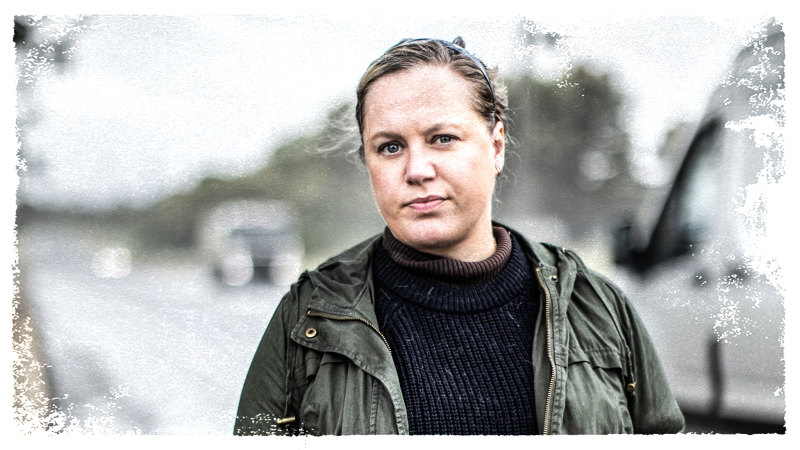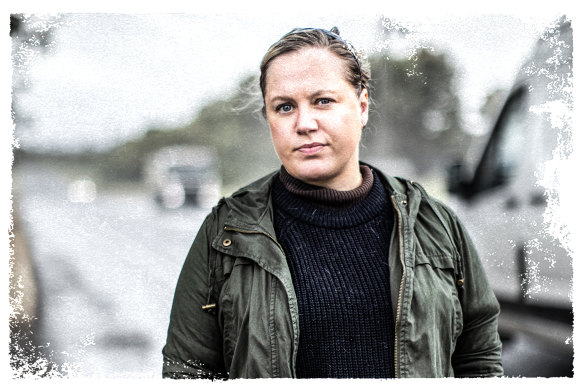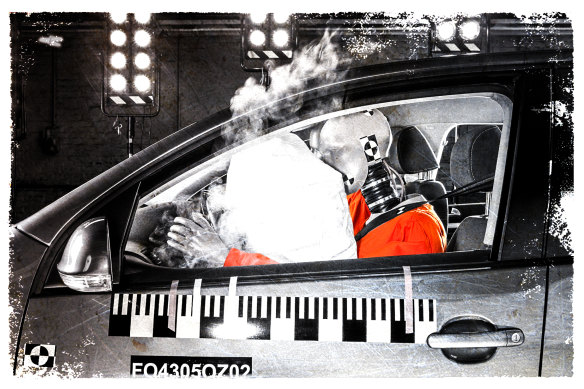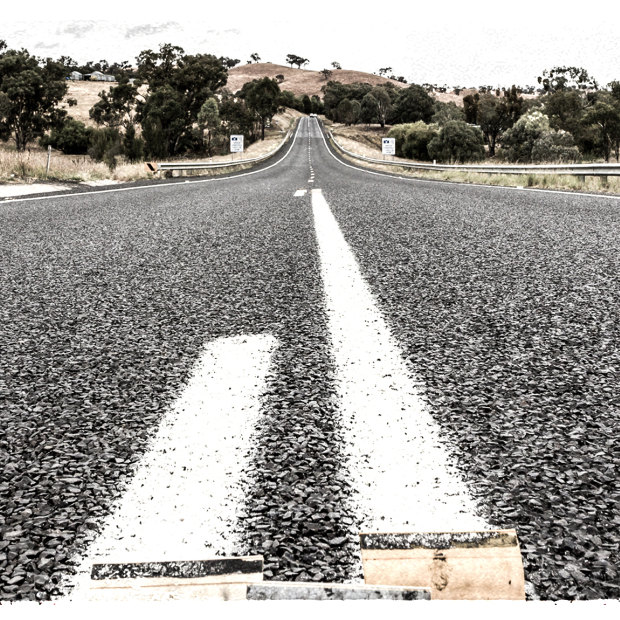Vehicle collisions kill an average three people a day in Australia. Drivers are often the focus of blame but other factors can play a part, including the design of the roads we hurtle along.
Save articles for later
Add articles to your saved list and come back to them any time.
Jessica Zaghet had just finished her first semester as a primary school teacher when a car crash changed her life. “I loved the kids and I loved being a teacher but it was full-on. So I was feeling relieved, thinking, finally, two weeks off,” she recalls.
Jessica was 24 and leading a busy life, playing netball and socialising with a tight group of friends in eastern Victoria. She said goodbye to her students in the town of Churchill and started the 20-minute drive on a country back road to her home in Traralgon.
What happened next isn’t completely clear. She was exhausted, and thinks that may have led to a moment of inattention. The last thing she remembers is seeing the truck in front of her and trying to swerve back into her own lane.
The truck driver was not injured but the collision crushed Jessica’s small car. She was airlifted to a hospital in Melbourne in a critical condition.
“Everything changed in one moment,” she says.
Road crashes kill more than three people every day in Australia, on average, and send another 100 to hospital. Twenty-five people a day sustain life-threatening injuries. Crashes are a leading cause of death among children aged between one and 14 and the second-biggest killer of those 15 to 24. Australia’s road fatality rate (4.26 deaths per 100,000 people) in 2020 was more than double those of the safest countries, Norway and Sweden, placing us 20th of the 36 nations in the Organisation for Economic Cooperation and Development (OECD) for road safety. Globally, road collisions kill 1.3 million people each year.
But while drivers are often the focus of blame, other factors can contribute to accidents too, such as the cars we drive and the roads we hurtle along. What part do they play? Why do people die on our roads? And what’s to be done about it?
Jessica Zaghet: “Everything changed in one moment.”Credit: Simon Schluter. Image has been digitally altered
First, what makes car crashes so catastrophic?
It was three months before Jessica woke again. She was in a rehabilitation centre and didn’t know where or who she was. Gradually, she regained her memory and her ability to speak and started the painful process of learning to walk. Eight months after the crash, she was finally discharged.
“We’re actually quite fragile creatures but in our minds we don’t see ourselves that way,” says Dr John Crozier, a Sydney trauma surgeon who has treated thousands of car-crash casualties over his three-decade career. “The forces imposed on the body in crashes, even at low speed … are well past the threshold where organs will be torn apart or shattered, and limbs will be torn apart and shattered.”
Jessica knows that some people will have little sympathy for her. After all, she was the one who drifted on to the wrong side of the road. But she is sharing her story because she wants other people to realise how easily the same thing could happen to them – even those who are confident they are “good drivers”. “I always did the responsible thing, I was always careful and still this happened to me,” she says. “It could happen to anyone.”
Imagine driving down a country road at 80km/h. Your car is full of kinetic energy – the energy of motion – created by your velocity (speed) and the mass of your vehicle. If you hit something, that energy has to go somewhere: it can generate heat and noise, be absorbed by the car frame that will bend, crumple and fold, and it can be transferred to the occupants of the car or anyone you hit.
Bodies are loaded with kinetic energy too. There’s a split second in a crash after impact when the car will have stopped but the driver’s body will keep moving until it is halted – by a seatbelt, an airbag, a steering wheel, a windshield or another part of the vehicle.
There’s a third impact, too: a body stops moving but its insides haven’t. Vital organs can hit bones with enough force to rupture. The brain can sustain fatal injuries from the force of hitting the inside of the skull. “So you do see patients slumped forward dead, with no obvious signs of injury to the face or other scalp structures externally, but that de-accelerating force was such that the brain has been extensively damaged,” Crozier says.
Brain injuries are the most common cause of death at a crash site. The second most common is an aortic rupture, where the body’s main artery is dislodged from the heart.
Jessica’s injuries were typical of those sustained in a head-on crash at speeds above 80km/h: a severe traumatic brain injury and haemorrhage, two collapsed lungs, fractures to her legs, ribs and spine and damage to her stomach muscles and organs.
Ruptured guts, bowels and bladders and paralysis are common too. Such injuries, says Crozier, can be “the price people pay to survive a crash.”
After an initial impact, there are other traumatic knocks to the body.Credit: Getty Images, digitally altered
What part do drivers play in crashes?
In almost every car crash, somebody has done something wrong: be it a dangerous illegal activity or a simple misjudgement of distance or speed. Queensland Police says most road deaths are caused by the “fatal five”: speeding, distraction, driving under the influence (of alcohol or drugs), fatigue and failing to wear a seatbelt.
Safe drivers aren’t necessarily ones with skill behind the wheel, says Narelle Haworth, a road safety researcher at the Queensland University of Technology. “Often confidence and skill actually contribute to risk taking, and to not only illegal but unsafe behaviours. What we need is alert and compliant drivers,” she says.
Drink-driving laws have helped cut road deaths by a third since 1970, as have better car design and lower speed limits. Victoria led the way in the world when it made wearing seatbelts mandatory, with other states quickly following. Still, 1247 people died in road crashes in the year to October 31 – 56 more than in 2019, and including 166 pedestrians, 244 motorcyclists and 41 cyclists. Progress in reducing road deaths hasn’t just stalled; since the COVID-19 pandemic it’s reversed.
Drivers spent nearly half of their time engaged in ‘secondary tasks’: adjusting seatbelts, fiddling with radios or air-conditioning, eating and drinking, touching their phones …
Nearly one in five drivers killed in crashes are over the blood-alcohol limit of 0.05 (that’s 0.05 grams of alcohol to every 100ml of blood). Drug use is estimated to contribute to as many as a third of fatalities. In 2021, 21 per cent of vehicle occupants killed in crashes weren’t wearing a seatbelt, according to federal government data. Meanwhile, the NSW transport department estimates that speeding is a factor in about 40 per cent of road fatalities and a quarter of serious injuries. Driving 5km/h over city limits and 10km/h over country limits roughly doubles the risk of a crash, according to Queensland’s Centre for Accident Research and Road Safety.
And the array of driving distractions has only increased over time. Haworth and other researchers put cameras in 346 cars in Victoria and NSW in 2015 and recorded their owners making a combined 194,961 trips. Drivers spent nearly half (about 45 per cent) of their time engaged in “secondary tasks”: adjusting seatbelts, fiddling with radios or air-conditioning, eating and drinking, touching their phones (either in their hand or in a holder), reaching for objects and doing “personal hygiene tasks”. Analysis of 43 hours of those recordings found 95 dangerous incidents, including eight distracted drivers swerving out of their lane, five failing to indicate and one failing to give way to a pedestrian.
“People drive as they live,” Haworth says. “A lot of the pressures of everyday life actually affect your driving. If you’re worried … or you’re feeling lonely then you’re more likely to use your phone more often, and then you’re more likely to be on the phone while you’re driving.”
Sometimes driver behaviour is so bad it becomes criminal: in Victoria alone, in the 12 months to July, 36 people were charged with dangerous driving causing death and 13 more were sentenced with the more serious charge of culpable driving causing death, according to the Sentencing Advisory Council. Over a broader range of offending, NSW police charged 2137 people with dangerous or negligent operation of a vehicle last year. Across both states, 80 per cent of drivers charged with those offences were men.
More than half of Australia’s road deaths could be addressed with measures such as barriers. Credit: Getty Images, digitally altered
How do some roads have death ‘built in’?
“We can’t make the driver perfect,” says Michael Fitzharris, associate professor at the Monash University Accident Research Centre. Police enforcement does make a significant difference to behaviour, he says, but it is impossible to stop people from ever doing the wrong thing – which is why looking at roads and cars is also important.
Drivers, cars and roads where crashes happened were all put under the microscope by Fitzharris and colleagues in a study of 393 crashes, involving 400 drivers hospitalised for injuries, published in 2020. Forty-five per cent of the drivers met the “safe” criteria; they weren’t speeding, using a phone, under the influence or excessively drowsy. But just 10 per cent of the vehicles passed the safety benchmark, which included a five-star safety assessment (more on that below), front and side airbags and electronic stability control.
Even the safest cars on the roads today can protect passengers from injuries in a front-on crash only at speeds up to 70km/h, and in side-on crashes at speeds of up to 50km/h. So the study gave a safety tick only to roads with speed limits below those thresholds, or that had infrastructure such as roadside barriers, separated lanes, turning lanes or roundabouts. Only a quarter of roads got a tick.
“People traditionally have reverted to blaming the driver,” says Fitzharris. “But we see clearly in our research that, even if compliant drivers are doing everything right, the vehicle and the broader road infrastructure is just not supporting them to be safe.”
There were only eight crashes in the study that involved safe drivers, cars and roads – and none of those led to serious injuries.
The stretch of country road where Jessica crashed is the type that another road-safety expert, Rob McInerney, is on a mission to eradicate: narrow, tree-lined, with a 100km/h speed limit and sometimes just a white line down the middle – not even a rumble strip to alert drivers they’re veering off course. While most people would drive on that road, at that speed, without giving it a second thought, McInerney suggests a thought experiment: close your eyes and imagine sitting in a deck chair on one side of that road while a truck zooms within centimetres of you at 100km/h.
“How safe would you feel?” he asks.
About two-thirds of Australia’s road deaths happen in regional and remote areas where roads like this are common.
‘We all make mistakes but we shouldn’t pay for our life for that mistake. Our buildings aren’t built without balcony rails, we have a door on the elevator shaft, but we can have a 10-metre drop on a roadside and think it’s normal.’
“The road with killer roadsides or the road with no sidewalks or safe crossings for pedestrians – every one of those has the risk of death built-in,” says McInerney. “So we shouldn’t be surprised when a crash happens.”
McInerney heads the International Road Assessment Programme (iRap), a charity that works with bodies such as the United Nations to eliminate dangerous roads around the world. “We’re all humans, we all make mistakes,” he says, “but we shouldn’t pay for our life for that mistake. Our buildings aren’t built without balcony rails, we have a door on the elevator shaft, but we can have a 10-metre drop on a roadside and think it’s normal.”
iRap has assessed more than a million kilometres of roads in more than 100 countries and given them a star rating out of five based on their inherent safety attributes. It looks at design features such as sidewalks and street lights for pedestrians, bike lanes for cyclists, and the width of the centre line that divides motorists driving towards each other. With each star improvement, the risk of serious crashes halves.
In Australia, based on iRap’s most recent look at 100,000 kilometres of roads, 58 per cent of our driving is on roads that are three-star or better. Updated ratings, due to be released next year, are expected to show a significant improvement, and the national road safety strategy has set a target of 80 per cent of travel being on three-star roads by 2030. Many of the safest countries for driving have already passed that goal: in Denmark, Ireland, the Netherlands, Spain, Britain and Switzerland, 85 per cent of travel is on roads that are three-star or more.
In Australia, a single vehicle running off the side of a road and crashing into a tree or pole or rolling down an embankment is the most common type of deadly crash, making up 37 per cent of fatalities in 2021, followed by crashes at intersections and head-on collisions (15 per cent each). McInerney says this shows more than half of Australia’s road deaths could be addressed with infrastructure: clearing roadsides, building barriers, separating two-way traffic and adding merging lanes or roundabouts, which force drivers to slow down.
Local governments are responsible for three-quarters of all roads and the states manage the rest, with some federal funding. This year’s federal budget included $976 million for road safety infrastructure projects, and the mid-year budget update will increase funding to states through its Roads to Recovery Program (from $500 million to $1 billion) and its Black Spot funding program (from $110 million to $150 million). “This additional investment in the Australian Government’s two cornerstone local roads investment programs will lead to safer and more productive roads across Australia,” a spokesperson for the transport department said.
What safety features should new cars have?
Until recently, cars have been built to protect occupants from the effects of collisions, with airbags, seatbelts and “deformation zones” that crumple to absorb kinetic energy. But new technologies mean cars now play a role in preventing crashes too (and we’re not talking about self-driving cars – it’s not clear if or when they will ever take over).
Autonomous emergency braking (AEB) uses radars to detect an impending collision and slams on the brakes. Other so-called Advanced Driver Assistance Systems (or ADAS) include collision alerts, blind-spot detectors, lane centring – which automatically steers you back to the centre of your lane – and adaptive cruise control, which maintains a safe distance from the car in front. Australia is making it compulsory for all new vehicles to have car-to-car AEB from March 2025, and that will expand to include car-to-pedestrian AEB from 2026. Such mandatory safety features are stipulated by the Australian Design Rules for new vehicles, which cover everything down to windscreen wipers.
Most new cars are also tested by the Australasian New Car Assessment Program; its star rating system is not mandatory, but aims to educate consumers and encourage carmakers to exceed minimum safety performance standards.
Meanwhile, safety experts are alarmed by the growing size, weight and shape of vehicles on our streets. A study released in November by the US Insurance Institute for Highway Safety found that large North American pick-up trucks and SUVs with high front hoods, which are becoming more common on Australian streets, are 45 per cent more likely to kill a pedestrian than shorter vehicles. Even “small cars” are bigger than they were a few decades ago – and all vehicles will get considerably heavier as they go electric.
So what can be done to reduce car crashes?
When Victoria experimented with upping speed limits on rural roads and freeways from 100km/h to 110km/h in 1987, fatal and serious injury crashes jumped 21 per cent. They fell 19 per cent when it reduced the speed limits again two years later. Deaths also fell around 20 per cent when state governments reduced their urban default speed limits from 60km/h to 50km/h around the turn of the century.
Road safety experts such as Fitzharris says it’s time for Australia to revisit its speed limits. “That has two effects: one, it gives the drivers more ability to make safe decisions because things are just that little bit slower,” he says. “But also, when a crash occurs, the vehicle has much more chance to protect them from serious injury and death.”
McInerney agrees speed limits on quieter country roads, where infrastructure upgrades might not be justified, should be reduced to 80km/h.
To understand why speed limits can have such a significant effect on road safety, it helps to look at the formula for kinetic energy: KE = ½mv². Because the amount of energy is determined by the square of a vehicle’s speed, a small increase or decrease in speed produces a big change in the potentially lethal energy involved. For example, when a two-tonne car slows from 85km/h to 75km/h, the speed has decreased 12 per cent. But the kinetic energy falls 20 per cent. (Studies of crashes show this 10km/h reduction will lessen the chance of a serious collision by 29 per cent.)
Meanwhile, default rural limits are 80km/h or 90km/h in much of Europe, and places such as Britain are rolling out 30km/h zones on local streets.
“Speed is the big-ticket item that I think we really need to look at still,” says Professor Rebecca Ivers, who heads UNSW’s School of Population Health, and who has worked extensively on road safety. “But it’s a cultural thing – we all think we’ve got a god-given right to get to where we want to go as quickly as possible.”
‘We’re not going to attack the road injury issue unless we get people out of cars and into other forms of transport.’
Ivers also makes a more fundamental point about preventing car crashes: does everyone need to be driving in the first place?
“You are always going to have recidivists drink drivers. So can we make sure that someone who’s got an addiction problem doesn’t feel like driving is the only option available to them because there is a bus or some other form of public transport,” she says. “We’re not going to attack the road injury issue unless we get people out of cars and into other forms of transport.”
State and federal governments have all committed to halving road fatalities and reducing serious injuries 30 per cent by 2030. The National Road Safety Strategy says it will invest in road upgrades, encourage safer vehicles and collect better data about road trauma, to better tackle the issue. Over the next two years, the strategy is also focusing on trucks, which are involved in 17 per cent of all road deaths.
All infrastructure and transport ministers met in Hobart on Wednesday to consider the strategy’s first progress report, which will be released in February. “Ministers noted their concern at the increasing national road toll,” a federal government spokesperson said.
Twelve years after her road crash, Jessica can now live without the help of a carer but chronic pain and other physical and psychological injuries mean she is unlikely ever to work again or to live the active life she once had.
Instead, she finds moments of happiness watching movies at home with friends, and visiting old school friends and their children. She volunteers with the road safety education charity Amber Community, where she talks to people about the effects of road trauma. “I’m just living whenever I can, with the life that I have left,” she says.
If there’s one thing she wants people to know before they get behind a wheel it’s this: “You have to be extremely careful and cautious when driving, at all times. I just want people to know about the damage they can do when they get in a car.”
Get fascinating insights and explanations on the world’s most perplexing topics. Sign up for our weekly Explainer newsletter.
If you'd like some expert background on an issue or a news event, drop us a line at [email protected] or [email protected]. Read more explainers here.
Most Viewed in National
Source: Read Full Article



